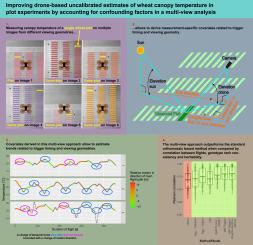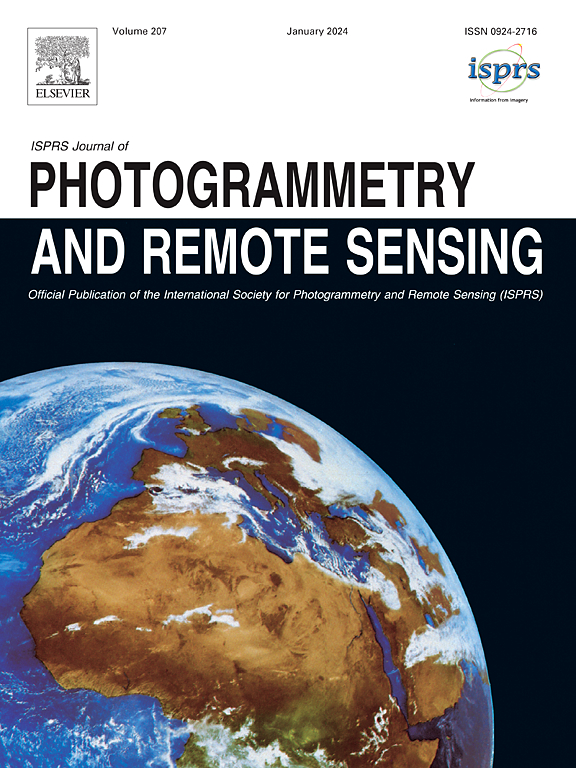Improving drone-based uncalibrated estimates of wheat canopy temperature in plot experiments by accounting for confounding factors in a multi-view analysis
IF 10.6
1区 地球科学
Q1 GEOGRAPHY, PHYSICAL
ISPRS Journal of Photogrammetry and Remote Sensing
Pub Date : 2024-10-11
DOI:10.1016/j.isprsjprs.2024.09.015
引用次数: 0
Abstract
Canopy temperature (CT) is an integrative trait, indicative of the relative fitness of a plant genotype to the environment. Lower CT is associated with higher yield, biomass and generally a higher performing genotype. In view of changing climatic conditions, measuring CT is becoming increasingly important in breeding and variety testing. Ideally, CTs should be measured as simultaneously as possible in all genotypes to avoid any bias resulting from changes in environmental conditions. The use of thermal cameras mounted on drones allows to measure large experiments in a short time. Uncooled thermal cameras are sufficiently lightweight to be mounted on drones. However, such cameras are prone to thermal drift, where the measured temperature changes with the conditions the sensor is exposed to. Thermal drift and changing environmental conditions impede precise and consistent thermal measurements with uncooled cameras. Furthermore, the viewing geometry of images affects the ratio between pixels showing soil or plants. Particularly for row crops such as wheat, changing viewing geometries will increase CT uncertainties. Restricting the range of viewing geometries can potentially reduce these effects. In this study, sequences of repeated thermal images were analyzed in a multi-view approach which allowed to extract information on trigger timing and viewing geometry for individual measurements. We propose a mixed model approach that can account for temporal drift and viewing geometry by including temporal and geometric covariates. This approach allowed to improve consistency and genotype specificity of CT measurements compared to approaches relying on orthomosaics in a two-year field variety testing trial with winter wheat. The correlations between independent measurements taken within 20 min reached 0.99, and heritabilities 0.95. Selecting measurements with oblique viewing geometries for analysis can reduce the influence of soil background. The proposed workflow provides a lean phenotyping method to collect high-quality CT measurements in terms of ranking consistency and heritability with an affordable thermal camera by incorporating available additional information from drone-based mapping flights in a post-processing step.

在多视角分析中考虑混杂因素,改进小区试验中基于无人机的小麦冠层温度非校准估计值
冠层温度(CT)是一种综合性状,表明植物基因型对环境的相对适应性。CT越低,产量和生物量越高,基因型的表现也越好。鉴于气候条件不断变化,测量 CT 在育种和品种测试中变得越来越重要。理想情况下,应尽可能同时测量所有基因型的 CT,以避免因环境条件变化而产生偏差。使用安装在无人机上的红外热像仪可以在短时间内测量大量实验数据。非制冷型热像仪非常轻便,可以安装在无人机上。不过,这种热像仪容易发生热漂移,即测量温度会随着传感器所处环境的变化而变化。热漂移和不断变化的环境条件阻碍了使用非制冷型热像仪进行精确一致的热测量。此外,图像的观察几何形状会影响显示土壤或植物的像素之间的比例。特别是对于小麦等行列作物,不断变化的观察几何形状会增加 CT 的不确定性。限制观察几何形状的范围有可能减少这些影响。在这项研究中,我们采用多视角方法对重复热图像序列进行了分析,从而提取出单个测量的触发时机和观察几何的信息。我们提出了一种混合模型方法,通过加入时间和几何协变量来解释时间漂移和观察几何。在一项为期两年的冬小麦田间品种测试试验中,与依赖正交马赛克的方法相比,这种方法提高了 CT 测量的一致性和基因型特异性。20 分钟内进行的独立测量之间的相关性达到 0.99,遗传率达到 0.95。选择斜视几何图形进行测量分析可以减少土壤背景的影响。建议的工作流程提供了一种简便的表型方法,通过在后处理步骤中纳入无人机测绘飞行的可用附加信息,利用经济实惠的热像仪收集高质量的 CT 测量结果,从而获得等级一致性和遗传力。
本文章由计算机程序翻译,如有差异,请以英文原文为准。
求助全文
约1分钟内获得全文
求助全文
来源期刊

ISPRS Journal of Photogrammetry and Remote Sensing
工程技术-成像科学与照相技术
CiteScore
21.00
自引率
6.30%
发文量
273
审稿时长
40 days
期刊介绍:
The ISPRS Journal of Photogrammetry and Remote Sensing (P&RS) serves as the official journal of the International Society for Photogrammetry and Remote Sensing (ISPRS). It acts as a platform for scientists and professionals worldwide who are involved in various disciplines that utilize photogrammetry, remote sensing, spatial information systems, computer vision, and related fields. The journal aims to facilitate communication and dissemination of advancements in these disciplines, while also acting as a comprehensive source of reference and archive.
P&RS endeavors to publish high-quality, peer-reviewed research papers that are preferably original and have not been published before. These papers can cover scientific/research, technological development, or application/practical aspects. Additionally, the journal welcomes papers that are based on presentations from ISPRS meetings, as long as they are considered significant contributions to the aforementioned fields.
In particular, P&RS encourages the submission of papers that are of broad scientific interest, showcase innovative applications (especially in emerging fields), have an interdisciplinary focus, discuss topics that have received limited attention in P&RS or related journals, or explore new directions in scientific or professional realms. It is preferred that theoretical papers include practical applications, while papers focusing on systems and applications should include a theoretical background.
 求助内容:
求助内容: 应助结果提醒方式:
应助结果提醒方式:


